It would not be difficult to argue that Crater Lake, in central Oregon, is the most beautiful body of fresh water in the world. The lake, which is almost perfectly circular in shape, in unquestionably startling. It sits at the top of a 7,000-foot-high dormant volcano and fills its crater. It is about six miles from side to side, a remarkable 2,000 feet deep (ranking it ninth in the world in terms of depth), and is almost entirely surrounded by cliffs that rise to heights of well over 1,000 feet above its chilly waters. No rivers or even streams flow into it; the lake is filled entirely with snowmelt and rainwater, and though it practically glows indigo in the North West’s summer sunshine, its water is actually so crystal clear that plant life has been found merrily photosynthesizing on the bottom at depths of 300 feet.
What makes Crater Lake unique, though, is its most celebrated occupant: not a fish, not a bird, but a floating tree trunk known familiarly for decades as the Old Man of the Lake. And what makes this ancient hemlock so very remarkable is that it has been bobbing, absolutely vertically, in the water for as long as Crater Lake has been documented. The Old Man has certainly been there for well over a hundred years, since the earliest known reference to it dates back to 1896 – and while its stump, two feet wide and bleached white by many years of sun, has lost a little of its topmost parts during that time (it used to project five feet above the surface, but now, thanks largely to the habit tourists had of jumping from their boats onto its tip, it has lost the top foot or two of its superstructure), this has not affected its stability. Like an iceberg, the Old Man hides most of its bulk beneath the surface; those who get close to it can look down and see some 30 feet of barkless trunk stretching down into the depths of the lake.
Why the Old Man floats so serenely, and has not either become completely waterlogged, or rotted, or been knocked to pieces as it crashed against the shore, remains something of a mystery. The most widely accepted theory suggests that when the tree fell into the lake – carried there, presumably, by some forgotten landslide – it took with it just sufficient rocks, trapped among its roots, to weigh it down and set it bobbing. Over time, the roots decayed and the rocks tumbled into the depths, but by then the trunk had become waterlogged, and the weight of that water kept it vertical. Meanwhile the sun, drying out the first five feet, gave the Old Man just sufficient buoyancy to remain afloat indefinitely; and the cold of the lake preserved it.
The first person to record the tree’s existence was J.S. (Silas) Diller, of the United States Geological Survey, who came to Crater Lake in 1883 and returned 13 years later. According to a report that Diller published in 1902, he noted, during a visit in 1896, the existence of a ‘great stump’ out in the waters of the lake near Wizard Island. At first Diller did not realise that the Old Man was floating; the tree had grounded in 37 feet of water, and, peering down through the clear waters, he presumed that it was rooted to the bottom and might constitute evidence that Crater Lake’s surface had risen considerably over time. Later, Diller established that the tree was mobile by tying bailing wire to the exposed portion and pulling it a short distance. [Salinas] Returning four years later, he noticed that the log was still there, but in a position about a quarter of a mile from where he had left it in 1896. This time he took a photo of it – the earliest known image that we have of the Old Man [below].
Diller’s extensive experience of Crater Lake makes it possible to hazard that the Old Man of the Lake probably began floating there some time between his first visit in 1883 and his encounter of 1896. One part of the geologist’s duties was to establish the crater’s depth, which he did in early in the 1880s by taking no fewer than 1170 separate soundings – covering every part of the lake without spotting (or at least without mentioning or later recalling) any floating tree.
At that time, the edges of Crater Lake were lined with trees, and Diller cut down several and slid them down the cliffs to make himself a raft. Yet while his observation that
owing to the steep slope of the rim, a tree frequently slides into the water in an erect position, and as the lower part becomes water-logged, it floats about the lake with only a few feet of the top projecting above the water and thus furnishes a spectacle to excite the imaginationmight suggest that the Old Man once had companions, no other cases of logs floating vertically in lakes for protracted periods have come to light; the Old Man seems to be unique, and it may be that Diller actually based his observation on nothing more than one or more encounters with the solitary denizen of Crater Lake. [Diller] For this reason (and because Diller’s description of the stump he discovered in 1896 matches that of the Old Man pretty well), it’s generally accepted that the trunk that appeared in Crater Lake c.1896 actually is the same one that is still floating there today.
By the 1920s, despite its continuing remoteness, the lake had become a minor tourist attraction, and visitor numbers were boosted by the growing popularity of outdoor activities such as camping, hunting and fishing. One early visitor was Zane Grey, the renowned writer of westerns, who fished there just after the Great War ended; well-travelled though he was, Grey was stunned by the lake’s setting, writing: ‘I expected something remarkable, but was not prepared for a scene of such wonder and beauty… Nowhere else had I seen such a shade of blue… How exquisite, rare, unreal!’ [Grey] It was not until 1928, however, that the Old Man of the Lake appeared again in the records. In that year, Fred Kiser, a photographer with the National Parks Service, gave the log its familiar name, and at about the same time (though some sources say in 1933), boatman Paul Herron, who made his living running tourist excursions on Crater Lake for several decades, finally established that several reports of a tree floating in different parts of Crater Lake actually referred to one and the same waterlogged trunk. [Pence; Crater Lake Institute chronology]
Undoubtedly the most interesting piece of research into the Old Man was conducted a decade later. Nothing that had been recorded up to that date suggested strongly that the tree was really mobile; indeed, Diller’s experience – of a tree that appeared to have moved 400 yards in four years – suggested that it barely shifted its position. In 1938, however, naturalists Wayne Kartchner and John Doerr took the trouble to track the Old Man’s movements over a three month period, recording its position once or twice a day wherever possible. The challenging weather of the lake (which is often shrouded in mist or wracked by high winds) restricted the total number of observations to 84, but these were sufficient to prove that – blown by the wind – the tree ranged over the entire lake, and could move at quite surprising speeds.
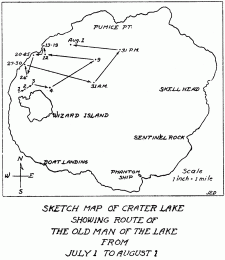

The Old Man's full length – around 30 feet – is visible at close quarters through the clear waters of Crater Lake. Note the absence of any root structure.
During that July and August, the two naturalists showed, the Old Man restricted itself almost entirely to the northern portion of Crater Lake. This pattern, they concluded, was the product of an almost continuous southerly wind, which ‘was deflected locally by the crater walls to the extent that numerous eddys and cross currents were created, thus accounting for the continuous back and forth movement of the floating stump.’
During September, the wind shifted, and for the duration of that month the Old Man travelled rather more
widely, going as far south as Phantom Ship
 and spending the last few days of the month to the west of Eagle Point. In total, the log travelled a measured total of 62.1 miles, or an average of about half a mile a day. Even that figure, though, is quite misleading; on 6 August 1938, for instance – a day when morning and evening observations were possible – the Old Man covered no less than 3.8 miles between dawn and dusk.
and spending the last few days of the month to the west of Eagle Point. In total, the log travelled a measured total of 62.1 miles, or an average of about half a mile a day. Even that figure, though, is quite misleading; on 6 August 1938, for instance – a day when morning and evening observations were possible – the Old Man covered no less than 3.8 miles between dawn and dusk.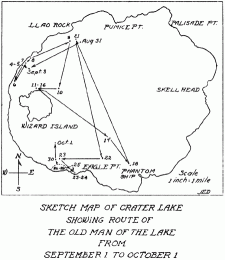
Both the longevity and the mobility of the Old Man, then, make it remarkable, though certainly no more remarkable than the body of water it calls home. It is not at all surprising to learn that the local Klamath tribe – who have lived in the vicinity for so long that they had no migration myth – regarded Crater Lake as sacred, and the tribe’s initiation rituals included (and still include) various death-defying feats conducted on the lake’s formidable cliffs. Among the Klamath’s legends, too, is one relating how the lake was formed in the course of a battle between the god of the underworld, Llao, and his rival, the sky god Skell. It has been suggested (perhaps not entirely plausibly) that this may be a dim folk memory of the eruption of the volcano, Mount Mazama, in about 5,680BC.
The eruption would certainly have been memorable, though – geologists estimate that Mazama stood 12,000 feet high at the time, which means that about a mile of mountain, the top 5,000 feet of rock, was shot into the sky in a single colossal blast. Certainly there is evidence of a deadly pyroclastic flow some 1,200 feet deep around the base of the mountain, stretching as much as 40 miles down into a nearby valley, and thick deposits of pumice and ash blanketed the whole North West. About 200 years later, in the course of a second eruption, Mazama collapsed in upon itself, forming the caldera which Crater Lake now fills.
It is certainly no surprise that a landscape so awesome and primaeval has given birth to numerous myths. What’s intriguing, at least for the purpose of this blog, is that just such a legend is showing signs of building around the Old Man of the Lake itself. The venerable log has been a fixture of Crater Lake for so long that it seems to be assuming the role of guardian of the waters – at least if the account of recent events there in the excellent Atlas Obscura are credited. According to this version of the Old Man’s story, when scientists began to explore the lake by submarine in 1988, it was decided that the floating log represented a dangerous hazard. Accordingly, the Old Man was tethered where they found it, east of Wizard Island, for the duration of the expedition. This restriction on the Old Man’s freedom produced some swift results. ‘Immediately upon doing so,’ it is said, ‘a storm descended upon the lake. The tempestuous weather only came to an end when the Old Man had broken away from his anchor and was again free to glide the water as he pleased.’
Source
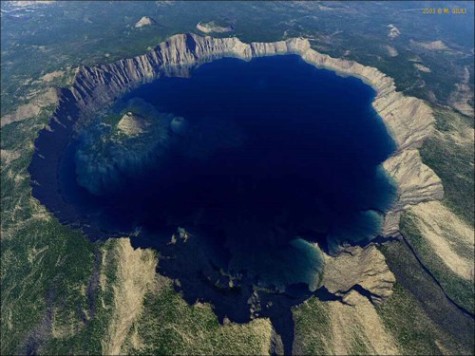


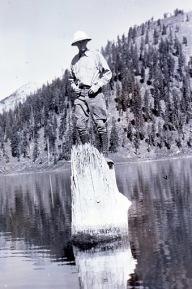

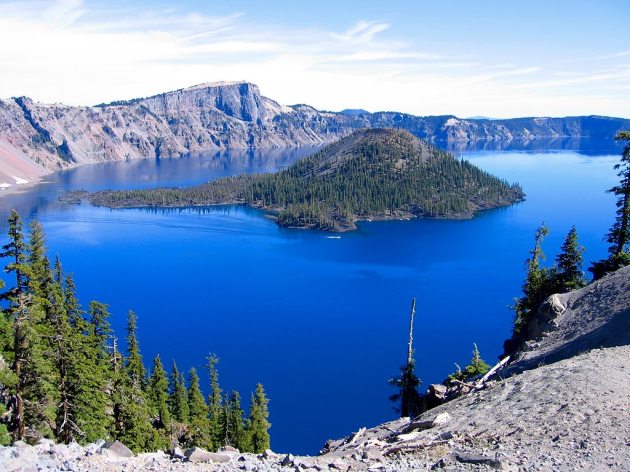
No comments:
Post a Comment